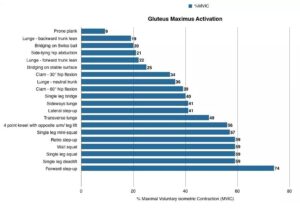LATERAL or SIDE LUNGES RESEARCH
Click on Image to Enlarge
MOMENT ARM STUDIES
HIP JOINT, KNEE JOINT, ANKLE JOINT
– Lateral Lunge with steps @9 Different Distances
A Biomechanical Study of Side Steps at Different Distances – 2012 – Inaba
Procedure
– Side steps at 9 different distances from 20% to 100% of person’s height
Results – Net Joint Moments
Hip Joint – Glute Max, Ad-ductors: increased 31x with increased distance
Knee Joint – Quads: increased 15x with increased stepping distance
+ Ankle joints – Calves: increased 12x with increased stepping distance
+ Hip Ab-duction muscles: work was not as sensitive to changes in side step distances; main roles of hip ab-duction torque and work were to accelerate center of mass laterally in earlier phase of movement and keep trunk upright, but not to generate large power for propulsion
HIP JOINT, KNEE JOINT, ANKLE JOINT
– Lateral Lunge Long & Short Step, Forward Lunge Long & Short Step
Biomechanical comparison of forward and lateral lunges at varying step lengths – 2013 – Bryan Riemann
Procedure
– recreationally active to active military
– compared sagittal plane joint kinematics and kinetics between forward and lateral lunges
– used self-selected and standardized (60% height) step lengths
Results Net Joint Moment Impulse
Hip Joint: forward lunge long 2.3 . forward lunge short 1.8 . lateral lunge long 1.4 . lateral lunge short 1.3
Knee Joint: lateral lunge long 1.1 . lateral lunge short 1.1 . forward lunge short 1.0 . forward lunge long 0.7
Ankle Joint: lateral lunge long 1.4 . lateral lunge short 1.4 . forward lunge short 0.7 . forward lunge long 0.7
EMG STUDIES
GLUTEUS MAXIMUS
– Sideways Lunge
Review of studies evaluating gluteus maximus and gluteus medius activation during rehab exercises . Michael Reiman – 2011
Procedure
– Studies that evaluated activation of GMax during rehab exercises; Note: subjects included in this review were healthy
Results for Gluteus Maximus
– the following can affect EMG activity:
(1) trunk position (2) movement direction (3) base of support
– EMG ranged from 74% to 9% MVIC; strength gains are expected for activation levels = or >40% MVIC
· 74% – forward stepup
· 59% to 56% – 1-leg squat; 1-leg RDL; wall squat; retro backward stepup; 1/4 squat
· 49% to 40% – transverse lunge; sideways lunge; lateral stepup; 1-leg bridge
· 39% to 34% – clam 60º hip flexion; lunge neutral trunk; clam 30º hip flexion
· 25% to 19%– bridging on stable surface; lunge forward lean; side lying hip ab-duction; bridging on a Swiss ball; lunge backward lean
· 9%– prone plank